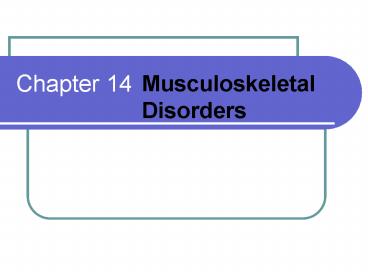Musculoskeletal Disorders - PowerPoint PPT Presentation
1 / 24
Title:
Musculoskeletal Disorders
Description:
Bursitis. Muscular shoulder pain. Nerve-related disorder. Neurovascular disorder ... Bursitis of the knee from kneeling. Prepatellar bursitis from vibration ... – PowerPoint PPT presentation
Number of Views:108
Avg rating:3.0/5.0
Title: Musculoskeletal Disorders
1
Chapter 14
- Musculoskeletal Disorders
2
Musculoskeletal Disorders
- Definition Intermediate-term (months/years)
effects of body activity upon the nerves,
muscles, joints, and ligaments. - The goal is to rid work of strain and pain.
- Emphasis is on reducing cumulative trauma.
- The ergonomic approach benefits everyone.
3
Approach to Reducing Musculoskeletal Disorders
- Written program
- Employee involvement and training
- Medical management
- Program evaluation
4
Main Occupational Risk Factors
- Repetition/duration
- Joint deviation
- Force
5
Risk Factors for Upper Extremities
- Repetitive use of hand
- Use of hand force
- Use of pinch grip for holding
- Non-neutral wrist posture
- Elevation of upper arm
- Local mechanical pressure
6
Repetition/Duration
- 30 s Rule A job is repetitive if the basic
cycle time is lt30 s. - Short duration lt1 h/day
- Moderate duration 1 2 hr/day
- Long duration gt2 h/day
- The body is self-repairing.
7
Joint Deviation
- Ideally, joint deviation should be zero.
- Express in relative as well as absolute terms.
- Posture affects joint deviation.
- Minimize torque about the joints.
8
Force
- Ideally, internal force on the joint should be
low. - The observed force external force moment arm.
- Reduce magnitude of external force, moment arm,
and duration.
9
Vibration
- Interferes with blood flow.
- Causes mechanical trauma to body.
- Handtool vibration increases grip forces.
10
Other Risk Factors
- Exposure to cold temperatures
- Trauma outside of work
- Anatomical or physiological imperfections
- Muscle tension from psychosocial factors
11
Solutions
- Prevent MSD from occurring
- Arrest MSD before symptoms appear
- Minimize consequences once symptoms have appeared
12
Identification of Problem Jobs
- Records and statistics from medical and safety
departments - Operator discomfort
- Interviews with operators
- Expert opinion
13
Engineering Solutions
- Analyze the job.
- Work to improve high-risk jobs first.
- Consider automation or mechanization.
- Consider job enlargement.
- Minimize joint deviation.
- Minimize force duration and amount.
14
Administrative Solutions
- Job rotation
- Part-time workers
- Exercise
- Stress reduction
- Supports
15
Medical/Rehabilitation
- Physical therapy
- Medication
- Surgery
- Ergonomist should work on the ergonomic problem
while medical personnel work on the person.
16
Hand/Wrist Problems
- In the tendons (e.g. tendonitis)
- In the nerves (e.g. carpal tunnel syndrome)
- In the neurovascular system (e.g. thoracic outlet
syndrome) - Carpal tunnel syndrome The median nerve through
the wrist tunnel that carries tendons from the
arm to the hand becomes pinched.
17
Risk Factors for Hand/Wrist Problems
- Internal force
- Repetitions
- Deviations
- Vibration
- Impacts
18
Engineering Solutions to Hand/Wrist Problems
- Repetition/duration Reduce lifetime use of the
joint. - Joint deviation Keep wrist in the neutral
position. - Force Reduce force duration and amount.
19
Shoulder/Neck/Elbow Problems
- Rotator cuff tendonitis, calcific tendonitis,
bicipital tendonitis - Tendon tears
- Bursitis
- Muscular shoulder pain
- Nerve-related disorder
- Neurovascular disorder
20
Engineering Solutions to Shoulder/Neck/Elbow
Problems
- Repetition/duration Minimize one-sided work.
- Joint deviation Keep the upper arm vertical
downward. - Force Reduce force duration and amount.
21
Back Problems
- Are extremely prevalent and costly (15 billion
annually). - Include
- Low-back pain
- Low-back impairment
- Low-back disability
- Low-back compensation
22
Low-Back Pain Risk Factors
- Individual physical factors
- Psychological factors
- Task demand factors
- Environmental factors
23
Low-Back Pain Solutions
- Address three basic problems
- Underuse of the back
- Whole-body vibration
- Overuse of the back
24
Leg Problems
- Bursitis of the knee from kneeling
- Prepatellar bursitis from vibration while
standing - Solutions
- Reduce time on the knees
- Use knee pads or mats































